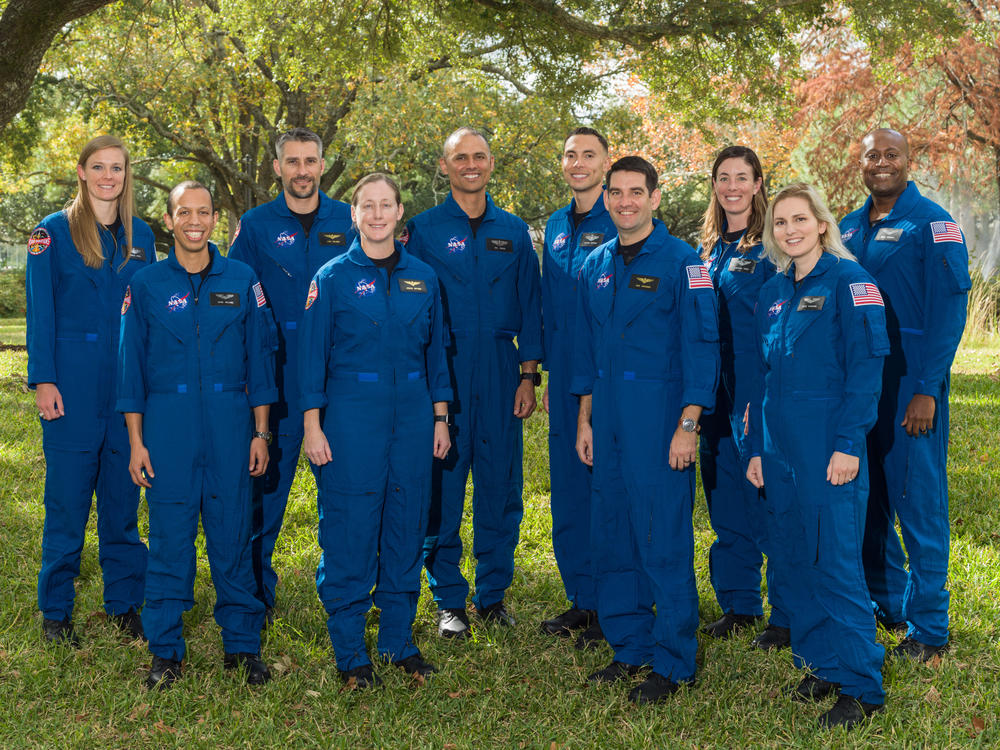Section Branding
Header Content
NASA names 2021 astronaut candidates as it plans for moon missions
Primary Content
NASA announced 10 astronaut candidates on Monday, selecting a group from more than 12,000 applications. The group, which includes four women, will train in hopes of being named to NASA's first human missions to the moon in more than 50 years.
The would-be astronauts reflect a broad stretch of America, from Alaska to Puerto Rico.
"Alone, each candidate has 'the right stuff,' but together they represent the creed of our country: E pluribus unum – out of many, one," said NASA Administrator Bill Nelson, as the agency introduced the new batch of astronaut candidates at an event at Ellington Field, close to NASA's Johnson Space Center in Houston.
It's NASA's first new astronaut candidate class in four years. They'll become eligible for flight assignments after their training, which will start in January and last around two years. The astronaut candidates will vie for a range of missions on and around the moon, as well as trips to the International Space Station.
"Today we reach further into the stars as we push forward to the Moon once again and on to Mars," said Vanessa Wyche, director of NASA's Johnson Space Center, which is home to both the astronaut corps and the Mission Control Center.
The core requirements for becoming an astronaut include U.S. citizenship and a master's degree in a STEM-related field (or equivalent course work), along with at least three years of related experience or 1,000 hours of experience piloting jets. Each candidate was also required to pass NASA's astronaut physical.
One year ago, NASA named 18 astronauts to its "Artemis Team," saying that the group likely included the next woman or man to walk on the moon.
The first launch in the Artemis lunar program will take place in 2022, when NASA will use its new Orion capsule and launch system in an uncrewed flight test. The second mission is expected in 2024, when a crew will loop around the moon. The next step will be Artemis-III, a crewed lunar landing mission.
"Each of you has amazing backgrounds," Pam Melroy, former NASA astronaut and NASA's deputy administrator, told the new class of astronaut candidates. "You bring diversity in so many forms to our astronaut corps and you stepped up to one of the highest and most exciting forms of public service."
The 2021 astronaut candidates, and any military rank they've achieved, are:
Nichole Ayers, 32, a major in the U.S. Air Force, is a native of Colorado and a graduate of the U.S. Air Force Academy. "Ayers is an experienced combat aviator," NASA says, adding, "One of the few women currently flying the F-22, in 2019 Ayers led the first ever all-woman formation of the aircraft in combat."
Marcos Berríos, 37, is an Air Force major who grew up in Guaynabo, Puerto Rico. "He is a test pilot who holds a bachelor's degree in mechanical engineering from the Massachusetts Institute of Technology and a master's degree in mechanical engineering as well as a doctorate in aeronautics and astronautics from Stanford University," NASA says.
Christina Birch, 35, is a track cyclist on the U.S. national team who grew up in Gilbert, Ariz., and graduated from the University of Arizona. She holds a doctorate in biological engineering from MIT and has taught bioengineering at the University of California, Riverside, and scientific writing and communication at the California Institute of Technology.
Deniz Burnham, 36, is a U.S. Navy lieutenant from Wasilla, Alaska, who once interned at NASA's Ames Research Center in Silicon Valley. "Burnham is an experienced leader in the energy industry, managing onsite drilling projects throughout North America, including in Alaska, Canada, and Texas," NASA says.
Luke Delaney, 42, is a major (retired) in the U.S. Marine Corps who grew up in Debary, Florida. An experienced test pilot and combat aviator, Delaney has "logged more than 3,700 flight hours on 48 models of jet, propeller, and rotary wing aircraft," NASA says.
Andre Douglas, 35, is from Chesapeake, Va., and graduated from the U.S. Coast Guard Academy. He holds numerous advanced engineering degrees. "He most recently was a senior staff member at the Johns Hopkins University Applied Physics Lab, working on maritime robotics, planetary defense, and space exploration missions for NASA," the space agency says.
Jack Hathaway, 39, is a U.S. Navy commander and a Connecticut native. NASA says: "He earned bachelors' degrees in physics and history from the U.S. Naval Academy and completed graduate studies at Cranfield University in England and the U.S. Naval War College. A distinguished naval aviator, Hathaway flew and deployed with Navy's Strike Fighter Squadron 14 aboard the USS Nimitz and Strike Fighter Squadron 136 aboard the USS Truman."
Anil Menon, 45, is the medical director at SpaceX. He rose to the rank of lieutenant colonel in the U.S. Air Force and was born and raised in Minneapolis, Minn. "Menon is an actively practicing emergency medicine physician with fellowship training in wilderness and aerospace medicine," NASA says. "As a physician, he was a first responder during the 2010 earthquake in Haiti, 2015 earthquake in Nepal, and the 2011 Reno Air Show accident."
Christopher Williams, 38, is a physicist who grew up in Potomac, Md. He graduated from Stanford and earned his doctorate from MIT in 2012. "Williams is a board-certified medical physicist, completing his residency training at Harvard Medical School before joining the faculty as a clinical physicist and researcher," NASA says.
Jessica Wittner, 38, is a lieutenant commander and test pilot in the U.S. Navy who is from Clovis, Calif. She studied aerospace engineering at the University of Arizona, and the U.S. Naval Postgraduate School. "Wittner was commissioned as a naval officer through an enlisted-to-officer program and has served operationally flying F/A-18 fighter jets with Strike Fighter Squadron 34 in Virginia Beach, Virginia, and Strike Fighter Squadron 151 in Lemoore, Calif," NASA said.
Copyright 2021 NPR. To see more, visit https://www.npr.org.

